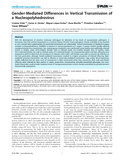Gender-mediated differences in vertical transmission of a nucleopolyhedrovirus
Fecha
2013Autor
Versión
Acceso abierto / Sarbide irekia
Tipo
Artículo / Artikulua
Versión
Versión publicada / Argitaratu den bertsioa
Impacto
|
|
10.1371/journal.pone.0070932
Resumen
With the development of sensitive molecular techniques for detection of low levels of asymptomatic pathogens, it
becoming clear that vertical transmission is a common feature of some insect pathogenic viruses, and likely to be essential
to virus survival when opportunities for horizontal transmission are unfavorable. Vertical transmission of Spodoptera exigua
multiple nucleopolyhedrovirus (SeM ...
[++]
With the development of sensitive molecular techniques for detection of low levels of asymptomatic pathogens, it
becoming clear that vertical transmission is a common feature of some insect pathogenic viruses, and likely to be essential
to virus survival when opportunities for horizontal transmission are unfavorable. Vertical transmission of Spodoptera exigua
multiple nucleopolyhedrovirus (SeMNPV) is common in natural populations of S. exigua. To assess whether gender affected
transgenerational virus transmission, four mating group treatments were performed using healthy and sublethally infected
insects: i) healthy males (H=)6healthy females (HR); ii) infected males (I=)6healthy females (HR); iii) healthy males
(H=)6infected females (IR) and iv) infected males (I=)6infected females (IR). Experimental adults and their offspring were
analyzed by qPCR to determine the prevalence of infection. Both males and females were able to transmit the infection to
the next generation, although female-mediated transmission resulted in a higher prevalence of infected offspring. Malemediated
venereal transmission was half as efficient as maternally-mediated transmission. Egg surface decontamination
studies indicated that the main route of transmission is likely transovarial rather than transovum. Both male and female
offspring were infected by their parents in similar proportions. Incorporating vertically-transmitted genotypes into virusbased
insecticides could provide moderate levels of transgenerational pest control, thereby extending the periods between
bioinsecticide applications. [--]
Materias
Vertical transmission,
Spodoptera exigua multiple nucleopolyhedrovirus (SeMNPV)
Editor
Public Library of Science
Publicado en
PLoS ONE 8(8): e70932S
Departamento
Universidad Pública de Navarra. Departamento de Producción Agraria /
Nafarroako Unibertsitate Publikoa. Nekazaritza Ekoizpena Saila /
Universidad Pública de Navarra/Nafarroako Unibertsitate Publikoa. IdAB. Instituto de Agrobiotecnología / Agrobioteknologiako Institutua
Versión del editor
Entidades Financiadoras
This work was supported by the Spanish Ministry for Science and Technology, project AGL2011-30352-C02-01. CV received a predoctoral fellowship
from the Universidad Pública de Navarra.







